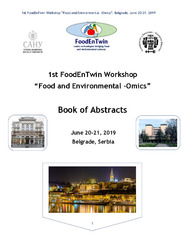Приказ основних података о документу
Interactions of ruthenium(II)-cymene complexes with cytochrome c
| dc.creator | Radomirović, Mirjana Ž. | |
| dc.creator | Stanić-Vučinić, Dragana | |
| dc.creator | Nikolić, Stefan | |
| dc.creator | Mihailović, Jelena | |
| dc.creator | Ćirković-Veličković, Tanja | |
| dc.creator | Grgurić Šipka, Sanja | |
| dc.date.accessioned | 2023-10-27T10:28:35Z | |
| dc.date.available | 2023-10-27T10:28:35Z | |
| dc.date.issued | 2019 | |
| dc.identifier.uri | http://cherry.chem.bg.ac.rs/handle/123456789/6037 | |
| dc.description.abstract | The ruthenium-based antitumour compounds act more via protein targets involved in carcinogenesis, in contrast to platinum-based compounds. Also, after intravenous administration of antitumour complexes proteins are the first binding targets in circulation. Therefore, interactions of anticancer compounds with proteins are important for elucidation of their pharmacokinetic pathways. Four half-sandwich ruthenium(II)-cymene complexes (C1, C2, C3 and C4), developed earlier and with promising cytotoxic activity, are investigated for their interactions with cytochrome c (Cyt). Complexes were incubated with Cyt for 48 h at 37 °C and high-resolution LTQ-Orbitrap ESI MS was used to monitor the formed adducts. The changes in heme state and tertiary structure around the heme were monitored by CD and UV-VIS spectra in the presence of oxygen. The complexes containing two chloride ligands (C2 and C3) were more reactive toward Cyt than those with only one (C1 and C4). The complex with S,N-chelating ligand (C4) was less reactive than one with O,N-chelating ligand (C1). All complexes reduced heme iron of Cyt, but the extent of reduction was inverse to the order of their reactivity to Cyt (C1>C4>>C2>C3). CD spectra in Soret region indicated that Cyt reduction was accompanied with slight tertiary structure change, the rupture of ferro-Met-80 and occupation of this heme coordination site by His-33/His-26. Extent of heme reduction by complexes inverse with respect to their reactivity implies that initially noncovalent binding of complexes occures, causing heme reduction, followed by comlex coordination to protein. In the presence of less reactive complexes more intensive reduction of heme leaves less available histidine residues (main targets for Ru coordination), leading to less efficient formation of adducts. | sr |
| dc.language.iso | en | sr |
| dc.relation | info:eu-repo/grantAgreement/MESTD/Basic Research (BR or ON)/172024/RS// | sr |
| dc.relation | info:eu-repo/grantAgreement/MESTD/Basic Research (BR or ON)/172035/RS// | sr |
| dc.relation | info:eu-repo/grantAgreement/EC/H2020/810752/EU// | sr |
| dc.rights | openAccess | sr |
| dc.rights.uri | https://creativecommons.org/licenses/by/4.0/ | |
| dc.source | 1st FoodEnTwin Workshop “Food and Environmental –Omics”, Belgrade, Serbia, 20th-21st June, 2019. In: Book of Abstracts | sr |
| dc.title | Interactions of ruthenium(II)-cymene complexes with cytochrome c | sr |
| dc.type | conferenceObject | sr |
| dc.rights.license | BY | sr |
| dc.citation.spage | 24 | |
| dc.citation.epage | 24 | |
| dc.citation.rank | M34 | |
| dc.type.version | publishedVersion | sr |
| dc.identifier.fulltext | http://cherry.chem.bg.ac.rs/bitstream/id/33247/1st_FoodEnTwin_Wokshop_BoA.pdf | |
| dc.identifier.rcub | https://hdl.handle.net/21.15107/rcub_cherry_6037 |


